In this guide, we will look at:
- What string dampeners and fret wraps are
- Why some guitarists consider using string dampeners cheating
- Popular string dampeners and what to look for
- How to get started using a string dampener
Whether you’ve never heard of string dampeners before or are wondering how to get started with one, this guide is for you.
What are String Dampeners?
A string dampener is exactly what it sounds like: a device that sits on your fretboard and dampens your strings. There are a few different designs, but they all aim to do the same job, keep your guitar nice and quiet.
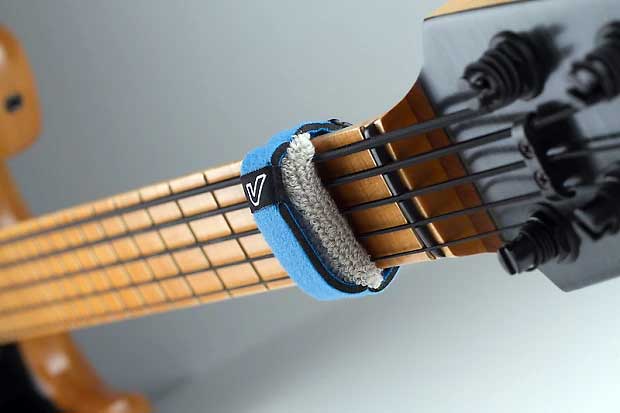
There are a few ways guitarists use string dampeners and I’ll go through the different ways to give you an idea whether one would suit you.
The most common way guitarists use string dampeners is in the studio when recording lead parts. For any parts that don’t use the open strings, string dampeners can significantly reduce the amount of string and fret noise during the recording.
A tiny amount of string noise can ruin an otherwise perfect take, so a string dampener can be used to keep the strings quiet while you focus on recording the best take possible.
The other common way guitarists use string dampeners is during live performances. This isn’t as common as studio use, but at some performances, you might notice a string dampener ready to go on the guitar’s headstock.

As you can see in the above photo, Guthrie Govan usually has a string dampener hanging over his headstock to use as a string dampener. While he may slide this over the strings for some parts of his performance, in that picture it’s still impacting his tone as I’ll explain next.
Why Use a String Dampener
There are two ways a string dampener can clean up your playing (even if you use perfect technique). I’ll explain each way so you can get the most out of any string dampener you buy.
Suppressing sympathetic resonance and overtones
Guitars are imperfect instruments. Pickups hum, guitar amps feedback, and strings vibrate when they’re not meant to.
While you may not have heard the term ‘sympathetic resonance’ before, you may have heard it on your guitar. Sympathetic resonance is the fancy way of saying “when something vibrates, something else vibrates as well”.
Have you ever noticed that sometimes if you pick a note, a different string starts vibrating? That’s sympathetic resonance in action.
Try this: without touching or muting any of the strings, pick the low E string really hard. Now lightly touch each individual strings and pay attention to any that feel like they’re vibrating.
The chances are you will notice the B string has started vibrating. Or pick the open B string hard and see what happens. The low E string may vibrate.
There are notes across the fretboard that will cause some open strings to start vibrating. While you may not notice this while you play, it does affect your overall tone.
When recording, sympathetic resonance can turn an otherwise perfect tone into a ‘pretty-good’ tone. But you’ll only notice how much of an impact it has on your tone when you properly mute everything.
While proper muting technique can eliminate a lot of this vibration, it cannot eliminate all of it.
Here is a big source of sympathetic resonance that cannot be removed with technique:
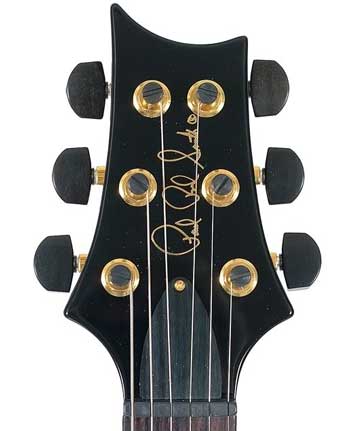
See those lengths of string behind the nut? You can’t mute them while playing and they will vibrate depending on what you play.
The harder you play or the louder you have your amp, the more these string lengths will impact your tone. You may not notice it, but you will notice the difference when those strings are properly muted.
I was shocked when I first placed a string dampener on those strings. I had no idea those tiny lengths vibrating could have any impact on my tone, but a quick A/B test confirmed that it did.
But if you place a string dampener on those strings (or foam or a piece of cloth behind the strings), it will eliminate any possible vibrations and clean up your tone during recording or live performances.
This is why guitarists like Guthrie Govan always have string dampeners or hair ties on the headstock. Even if they never move them over the strings while playing, they’re always suppressing vibration that would impact their tone.
So even if you have no interest in using a string dampener to mute your strings while playing, I highly recommend putting something in place to eliminate sympathetic resonance behind the nut.
Suppressing String Noises
Even if you have fantastic muting techniques, using a string dampener when playing any leads is a good idea.
Why? Try this test:
Use your picking hand to mute all the strings near the bridge. Now use your fretting hand to hammer-on hard to any note. What do you hear?
On top of the sound of your finger hitting the string and the string hitting the fret, you will hear a note sustain.
The note you hear is the string vibrating from the nut to your finger as shown below:
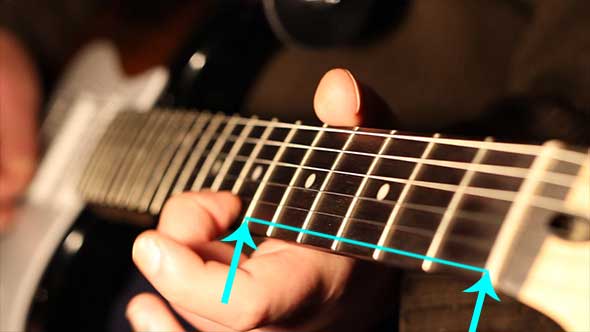
We don’t notice this during normal playing because the main notes are far louder. But they’re always there in the background.
Every time you place a finger onto a string, the string will vibrate from the nut to the fret before your finger. That means even if we don’t notice these notes, they impact our tone.
By using a string dampener while playing any parts that don’t use the open strings, you can eliminate these background notes.
If you’re planning on recording anything that doesn’t use open strings, a string dampener can clean up your recordings – even if you already use perfect muting techniques!
Are String Dampeners Cheating?
Whenever you hear somebody see or mention a string dampener or fret wrap, you will also hear people saying that it’s cheating. You will hear people say things like “real guitarists don’t need them”, “[amazing guitarist’s name] doesn’t use one” or “it’s a crutch for poor technique”.
Instead of tearing somebody apart for using one, let’s take a level-headed look at whether string dampeners are cheating or not.
A string dampener is a tool, just like a capo, tuner, or pick. Are those tools cheating, too? Let’s look at other tools guitarists use and whether they’re cheating or not:
Is using a capo cheating? If somebody said “capos are just for people who have poor technique and can’t be bothered learning new chords”, you might give them a strange look. While some guitarists do use capos to cover up their limited chord knowledge, it’s a bit far-fetched to say that using a capo is cheating.
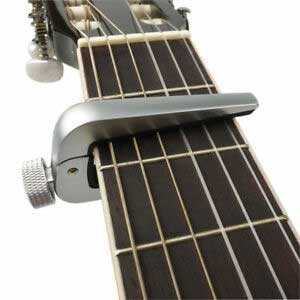
A capo is a useful tool to let you play in new ways, come up with new ideas, or transpose songs quickly to match a vocalist’s needs. There are plenty of reasons why capos are useful.
Is using a guitar tuner cheating? Do you hear people say “tuners are for tone-deaf people”? Surely a pedal that tells you if your string is out-of-tune is cheating, right? Why don’t you just learn to tune by ear without any reference pitch?
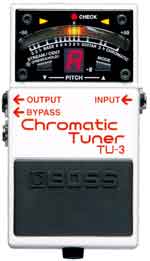
Nobody says tuners are cheating because it’s obvious that they’re useful. While you might be able to tune your guitar by ear, tuners are far more precise. They’re useful tools and guitarists who use them instead of tuning by ear are not cheats.
Is using a guitar pick cheating? It makes a lot of things far easier to play, so it’s a cheat, right? “What, you’re not good enough to play everything with your fingers? Picks are cheating!”.
A pick is a tool that allows you to play things that would be ridiculously difficult or outright impossible without one. While that sounds like cheating, it’s clear that guitarists don’t call out picks as cheats.

The more you think about it, the easier it is to find other tools that could be called cheats. Light string gauges is a cheat to make it easier to play bends. Low action is a cheat to play faster. Noise gate pedals are cheats to make you sound better. Guitar amps are cheats that take your thin and weak tone and transform it into something better. Frets are cheats to improve your intonation – show me a violin with frets.
The key point I want to make is that we use tools all the time to improve our tone and make playing guitar easier. Whether you choose to use a string dampener or not is a choice you can make, just like using a capo, tuner, or pick. Tools can be used for good reasons, or they can be used to hide poor technique or laziness.
To call a tool such as a string dampener, capo, or guitar tuner a cheat is lazy thinking.
As explained earlier, even if you use perfect muting techniques, your strings are still going to vibrate in ways you don’t want them to. Dampening the strings past the nut isn’t cheating – it’s fixing a flaw in the way guitars are designed.
Cheating what?
Guitarists can be competitive. It’s pretty standard to see a guitarist watch a video of somebody else play and scoff: “I can do better”. But music isn’t a competition. It isn’t a sport where there are winners and losers. There aren’t any Gold medals to hand out.
A guitarist who uses a string dampener to make a complicated eight finger tapping sequence sound cleaner for a recording isn’t cheating. If the string dampener makes it easier to express his ideas in his music, there’s nothing wrong with that. It’s not cheating because music isn’t a competition.
Other people say string dampeners are cheating the guitarist who uses one. The idea is that the string dampener is holding the guitarist back and preventing them from learning ‘proper’ technique.
For some guitarists, that’s true. Some guitarists do use string dampeners to avoid learning proper muting techniques. But even in those cases, the guitarist can easily go back and learn those techniques. There’s nothing wrong with using a fret wrap as a temporary crutch to help guitarists express themselves.
The key point to remember is that string dampeners are just tools you can use or not use. There are no rules when it comes to playing guitar, so you’re not cheating if you use one.
Best Guitar String Dampeners
There are a few different options if you’re looking at using a string dampener. I’ll go through all of the most popular options so you can decide which is right for you.
Hair ties or scrunchies (the DIY approach)
The cheapest option is surprisingly common. Typical hair ties or scrunchies work surprisingly well at muting your strings while you play.

If you’re a woman or you live with a woman, the chances are there will be multiple hair ties lying around your house right now. You can try one out right now and see what all the fuss is about.
While hair ties don’t work as well as a fret wrap designed specifically for muting guitar strings, they do a good enough job for you to mute your strings when you need to. I’ve seen plenty of photos of Guthrie Govan using hair ties.
FretWraps by GruvGear
The most popular option for string dampeners are the FretWraps designed by GruvGear. These provide far more padding than a typical hair tie and come in multiple sizes to properly fit your guitar’s neck.
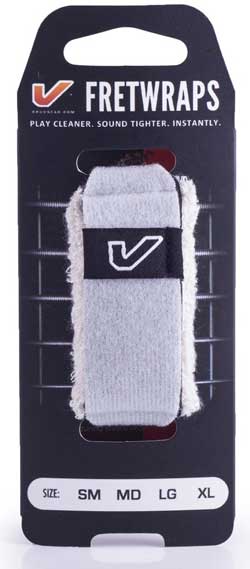
The extra padding in these fret wraps means you get better control over muting your strings. With one of these in place, it’s possible to play very aggressively or loosely without worrying about sympathetic resonance or string noise.
Check out the different FretWraps sizes and options here.
MAB String Dampener
While Michael Angelo Batio (MAB) is a technically brilliant guitarist, I couldn’t help but poke some fun at his string dampener in this article.
In truth, it’s a very well designed string dampener that uses a clamp system to allow quick apply or release onto the strings:
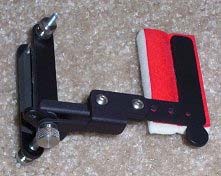
You can see him use these dampeners with his double or quadruple-neck guitars.

They work extremely well, but at a cost. The reason I poked some fun at this option in that other article is that they’re quite expensive.
You can pick up a handful of hair ties for a few dollars, or a 3-pack of FretWraps for around $30, while the MAB String Dampener will cost you $100.
It’s a great design, but for almost all guitarists you’ll get just as good results for a lot less money using a standard fret wrap.
Using a String Dampener
A string dampener can be a helpful tool in cleaning up your tone. Even if you only use it to suppress sympathetic resonance past the nut, your recordings and your live tone will sound better.
While it’s important to develop good muting techniques, a string dampener can be used to assist with muting.
Some guitarists will still tell you that string dampeners are cheating, but music isn’t a competition. Use whatever tool you want to help you express your music.
